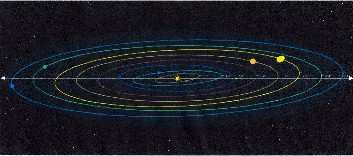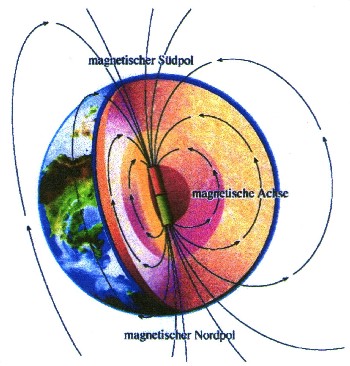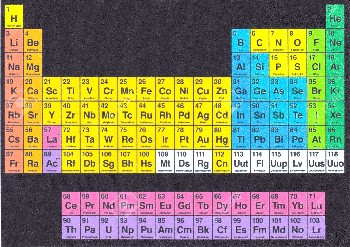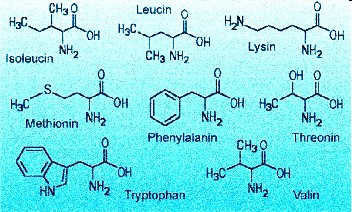In the previous
chapter it could be clarified, how many earth-like
planets exist, which could offer a basis for life. The
prerequisite for life is the presence of basic building
materials such as carbon, nitrogen, oxygen, sulphur,
phosphates and trace elements. And water, of course.
| 4.1.1 Axiom |
If the basic building
materials and suitable reaction environments are
present in the universe, then the basic building
blocks of life, such as amino acids, also arise
there. |
| |
|
| 4.1.2 Axiom |
The basic building blocks of
life are created, under appropriate conditions,
throughout the universe. |
Planetary
Assumptions for Life are:
1) Stable orbit in habitable zone
 |
An orbit in
the habitable zone is necessary to obtain
temperature conditions suitable for life.
Furthermore, the orbit must have a certain time
stability, otherwise the climate and weather
conditions would change too drastically. Even
small changes in the orbit cause long-period
climatic changes, which can result in recurrent
ice ages. |
The
distance of the planet must be regulated in such a way
that gravity and size of the planet are dimensioned in
such a way that firstly a stable atmosphere can develop
and secondly that the triple point of the water is
stable. This is a fixed area between solid, liquid or
gaseous, which results from distance, gravity (mass of
the planets to each other), as well as centrifugal and
centripetal forces. [1]
2) Stable axis of rotation
 |
A stable
rotation axis is necessary to maintain regulated
and stable seasons. The inclination of this axis
determines the seasons. [2] The inclination of
the axle should not be too large and the
precession should not be too large to avoid
greater climate and weather changes.
The duration of the precession should also not be
too short. The inclination of the earth's axis is
23.44° from Earth's orbit and
the precession is 25,800 years. |
| |
|
 |
Apart from
stabilizing the axis of rotation, the moon also
has an influence on the earth and thus on climate
and weather via the tides of the oceans.
The moon has a diameter of 3,476 km
and is 384,400 km away from the
earth.
After a sidereal month (27.32 days) the moon
takes the same position to the fixed stars again.
Since he also turns around himself once, he
always turns the same side to the earth.
|
The
following options are available for a stable axis of
rotation:
a) one or more moons are present
b) a two-planetary system
c) as the moon of a much larger planet
3) Stable magnetic field, electric field (trigger
signals, volcanism)
 |
An
(electro)magnetic field that has a certain
temporal stability to a planet [3] is imperative
to selectively protect against cosmic radiation
and/or solar wind. Only defined parts of the
particle flow of charged particles of solar
origin (as well as parts of the light from IR,
via visible to UV) are passed through. These are
the "solar frequencies". Defined
atmosphere windows exist for these specific
frequencies. [4] The Earth's magnetic field is
generated by rotating magma masses inside the
planet. This is one of the reasons why volcanism
and plate tectonics occur simultaneously, which
play an important role in shaping life. This
magnetic field contains the "geomagnetic
frequencies". Another essential trigger
signal is the "Schumann frequency"
(7.83 Hz). The Schumann frequency is created by
the formation of a standing wave with a cavity
resonator frequency between the ionosphere and
the earth's surface. [5] The frequency is a
consequence of the distance ionosphere-earth
surface and circumference. In this respect, a
stable ionosphere is even a prerequisite and the
Schumann frequency is a consequence. These
"geomagnetic frequencies" are essential
signals in conjunction with the
"Schumann" and "solar
frequencies", so that a highly complex
structure such as that of the hereditary
substance as a "blueprint" and the
structure of highly specific organs, enzymes,
proteins and above all nerves can be clearly and
perfectly performed and the function of all parts
and elements can function together perfectly. [6] |
These signals are
necessary for the development of living beings to
synchronize all structural, organic, nervous and mental
processes. Overall, therefore, an electromagnetic field
is required which has a certain temporal stability. As a
result, the Geodynamo must remain active for billions of
years. An example, if the Geodynamo comes to an early
standstill, is Mars. Once like earth with continents,
oceans and atmosphere, it became a dried out planet due
to the failure of the geodynamos and thus the magnetic
field.
4) Stable atmosphere (light, shielding UV
radiation, climate, weather)
 |
A stable atmosphere is necessary to protect
against UV radiation and smaller asteroids or
comets. In addition, a better light distribution
is achieved through the atmosphere. In addition,
the atmosphere at night also determines climate
and weather. [7] [8] A long-term stable
atmosphere, with the associated climate systems,
prevents an irreversible greenhouse effect, [9]
as it has occurred on Venus. An atmosphere is
also needed so that plants and living beings can
develop. |
5) Water (oceans, weather, climate)
 |
Water is
needed to create life and living beings need
water to live. [10] The presence of water
requires oceans and these in turn influence the
weather and climate of the planet. In total, 71%
of the earth's surface is covered by seas, i.e.
the oceans and their secondary seas. About 3%
of the water on earth is fresh water. Most of it
exists as frozen ice at the poles. Only about 0.03%
of the world's water resources can be used as
drinking water. |
6) Continents (plants, climate, weather)
 |
Volcanism and
thus plate tectonics are generated by rotating
magma masses inside the planet. This creates
continents. [11]
Continents are needed for plants and organisms to
develop. The migration of continents changes
fauna and flora. Especially at the edges of the
plates volcanic activities can occur. Continents
also have an impact on climate and weather. |
7) Basic building materials (chemical elements)
 |
There are a
number of chemical elements and their compounds,
such as salts and minerals required to bring
about life. [12] There are 4,603
minerals on Earth. |
8) Basic building blocks of life (amino acids)
 |
The building
blocks of life are amino acids. These must be
present for life to develop. [13] There are 21
amino acids. Four of them are used in DNA, namely
adenine, cytosine, guanine and thymine.
|
 |
4.1.3 Axiom If
the planetary assumptions for life are given on a
planet, then life also develops there.
|
|